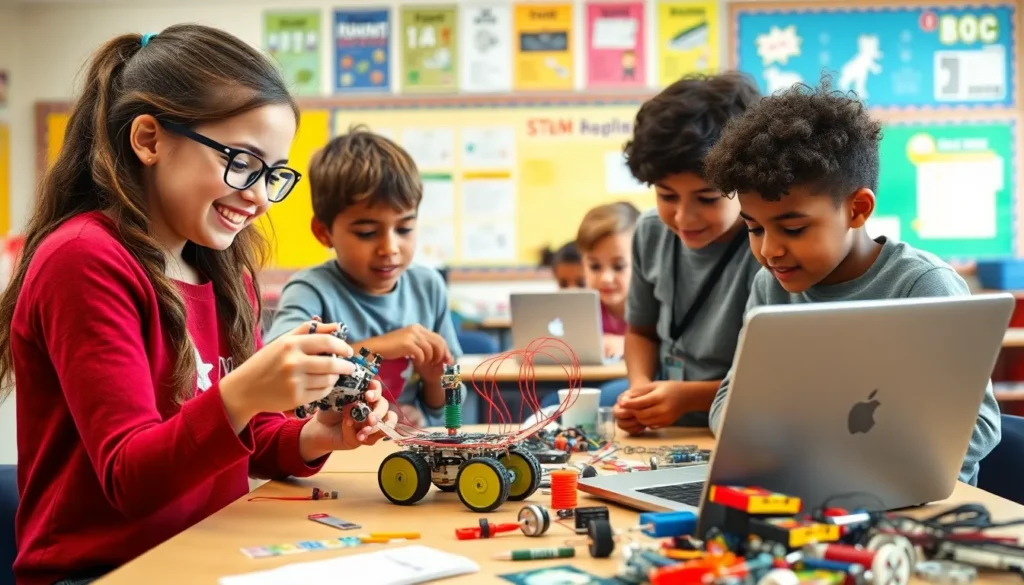Table of Contents
ToggleIn a world where innovation reigns supreme, educators are caught in a friendly turf war: STEAM vs. STEM. On one side, you’ve got the no-nonsense STEM warriors, armed with science, technology, engineering, and math. On the other, the STEAM advocates, who believe the arts should join the fray, adding a splash of creativity to the mix. It’s like a well-balanced diet—sure you can survive on just protein, but wouldn’t you miss those delicious carbs?
Overview of STEAM and STEM Education
STEM and STEAM education approaches aim to equip students with essential skills in increasingly complex fields. While both share common goals, they differ primarily in their emphasis on creativity and the arts.
Definition of STEM Education
STEM education focuses on the core subjects of science, technology, engineering, and math. This framework prioritizes analytical thinking, problem-solving, and technical skills. Curriculum components often include hands-on projects that reinforce practical applications. Engaging students in experiments and coding activities enhances understanding of scientific principles. Programs frequently collaborate with industries to ensure relevance to current job markets.
Definition of STEAM Education
STEAM education builds upon the STEM framework by integrating arts into the curriculum. This approach recognizes the importance of creativity in fostering innovation. Specific activities in STEAM include design challenges, artistic projects, and interdisciplinary learning. Creative thinking promotes adaptability and enhances student engagement. By blending analytical and artistic methods, students develop well-rounded skills applicable to diverse fields.
Key Differences Between STEAM and STEM

STEAM and STEM share common goals but differ significantly in their approaches. Integrating the arts into the curriculum distinguishes STEAM from STEM.
Incorporation of Arts in STEAM
In STEAM education, arts play a crucial role. They provide students avenues for creative expression through visual arts, music, and performing arts. Projects in STEAM often combine artistic design with technical skills. For instance, students might create engineering prototypes that include aesthetic considerations, enhancing functionality with visual appeal. Incorporating arts fosters interdisciplinary collaboration. Collaborating across fields produces innovative solutions, making learning more engaging. Art projects not only encourage creativity but also help students understand complex scientific concepts more deeply.
Focus on Creativity and Innovation
Creativity remains a central pillar of STEAM education. STEAM fosters innovative thinking by encouraging students to approach problems from various perspectives. Artistic activities stimulate imagination, prompting students to develop unique solutions. For example, integrating design thinking into STEM challenges cultivates an environment where innovation thrives. Problem-solving becomes a process enriched with creative exploration in STEAM. Students learn to embrace failure as part of the creative process. This mindset enhances resilience and adaptability, skills increasingly vital in today’s rapidly changing job market.
Benefits of STEAM Education
STEAM education offers several advantages that enhance students’ learning experiences.
Enhancing Critical Thinking Skills
Critical thinking skills improve significantly through STEAM education. Students analyze problems, construct solutions, and apply various methodologies. This approach encourages them to ask questions and explore diverse viewpoints. Engaging with arts in projects stimulates creative thinking, which complements scientific reasoning. Students learn to synthesize ideas across disciplines, leading to innovative outcomes. Moreover, the integration of multiple subjects enhances their ability to evaluate information critically. This synthesis of thought empowers learners to tackle real-world issues effectively.
Promoting Engagement and Collaboration
Engagement levels rise in STEAM education. Students participate actively in hands-on activities that foster collaboration. Group projects promote teamwork and communication, essential skills in any career. Integrating arts into scientific inquiry creates a more dynamic learning environment. Students connect with peers from different backgrounds, exchanging ideas and perspectives. Such interactions cultivate a sense of belonging and encourage shared problem-solving. Creativity nurtures enthusiasm, inspiring students to invest more in their education. Overall, collaboration within STEAM frameworks enhances learning outcomes and prepares students for future challenges.
Benefits of STEM Education
STEM education offers numerous advantages that contribute to students’ development and future success.
Emphasis on Technical Skills
Technical skills play a crucial role in STEM education. Students immerse themselves in hands-on projects, learning coding, robotics, and engineering principles. These experiences provide real-world applications of complex concepts, making learning more relevant. Analytical thinking fosters problem-solving abilities essential for success in technical fields. STEM emphasizes the importance of data analysis, critical for decision-making in various industries. Through project-based learning, students gain practical experience, building confidence in their abilities and ensuring readiness for future challenges.
Preparing for Future Careers
STEM education equips students for a competitive job market. With technology evolving rapidly, employers seek candidates who can adapt quickly. Proficiency in science and math ensures a strong foundation for careers in engineering, information technology, and healthcare. Data from the U.S. Bureau of Labor Statistics highlights that STEM occupations will grow significantly over the next decade. Students gain skills for in-demand careers, securing their employment prospects after graduation. Career exploration in STEM fields often begins in school, providing students with valuable insights into future pathways.
The debate between STEM and STEAM education underscores the importance of balancing technical skills with creativity. As the job market evolves students need more than just analytical abilities; they require innovative thinking and adaptability. STEAM education offers a unique approach by integrating the arts into the curriculum fostering a holistic learning environment. This blend not only enhances problem-solving skills but also encourages collaboration and diverse perspectives.
Ultimately both educational frameworks play crucial roles in shaping future leaders. By understanding the strengths of each approach educators can better equip students for the complexities of modern careers. Embracing both STEM and STEAM ensures that learners are prepared to tackle real-world challenges with confidence and creativity.






